National Chemistry Week Awes, Teaches and Inspires
Nov. 1, 2012
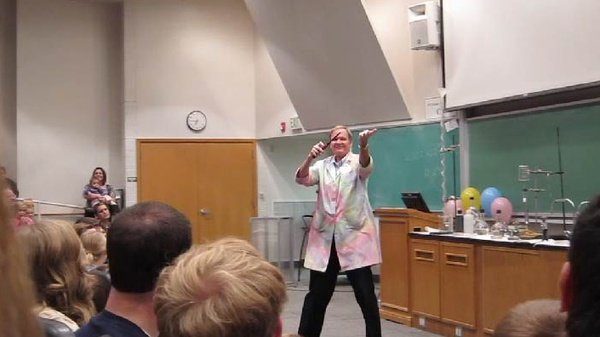
The cotton disappeared in a flash of fire. Dr Steve Wood smiled at the scattered oohs, aahs and yelps from the audience as he lifted the tile square the cotton had been sitting on, emphasizing the tile’s emptiness. He put down the tile, picked up another piece of nitric acid-treated cotton and made a show of laying it on his bare palm, turning his head as if afraid to watch as he aimed his lighter at it.
“Do it! Do it! Do it!” some of the younger audience members chanted. The lighter retreated as the BYU chemistry professor leveled a mock glare at the crowd.
“It’s my hand, not yours!” he scolded, earning a round of low chuckles from the adults. Then Wood’s smile returned and he quickly touched the flame to the cotton. There was another flash and it was gone. He held up his hand, unscathed by the fast-burning fuel, and the room burst into applause.
Chemical Magic shows like Wood’s, aimed at teaching chemical principles through crowd-pleasing demonstrations, went on all week at the Benson Science Building on the BYU campus, Oct. 22-26. The shows, hosted and performed by the Department of Chemistry and Biochemistry, were only one sampling of activities the department planned to celebrate National Chemistry Week.
This year’s theme was “Nanotechnology: the Smallest BIG Idea in Science.” The department encouraged people to learn more about science by organizing a “nano" symposium Wednesday, Oct. 24, a research poster session and reception Friday, Oct. 26 and the “magic” shows throughout the week.
Dr. Eric Sevy had a special guest at his Chemical Magic show Thursday, Oct. 25. The family of a local boy fighting A.L.L. leukemia arranged to have him help Sevy in the show. Seven-year-old Connor helped create a tornado of fire, demonstrated the effect of liquid nitrogen on balloons, excited the sugars in two clear liquids to change them to pink and blue, and more.
Officers from the student council at Springville High School arranged with Y-Chem Society president Joel Everett and executive department secretary Sue Mortensen to include Connor, who loves science, in the magic show. The Springville student council also organized a number of fundraisers during the week to help raise money for Connor’s wish for a hot tub via Make-A-Wish Utah. Between the public community fundraiser (a carnival held at the school Oct. 22), fundraising activities among the students (including “spook-o-grams” and cotton candy sales during a Springville football game) and personal donations, Springville High has raised just over $3,000 toward Connor’s wish, according to Springville student council advisor Angie Meacham.
For the Nano Symposium, graduate students Trevor Smith, Elizabeth Gates and Chad Jones, along with professor emeritus Gerald D. Watt, co-taught the symposium. Each person presented about a nano-related research project they are working on and took questions from the audience as time allowed. Smith spoke of using ferritin, a protein in the body that stores iron, to form a nano-bio-explosive by replacing the stored iron with a more explosive compound. Smith is currently working in the lab of Richard Watt on two projects involving explosive ferritin: one with NASA and one with the Department of Defense.
Dr. Matthew Asplund, professor of chemistry and chair of the ACS Central Utah Section, introduced Gates’ talk on nano-origami:
“One of the great promises of nanotechnology is that if we can build things from individual units, we can make very small, very functional things. ... And one of things on the nanoscale is getting the shape right. So nano-origami is an example of building a well-defined shape on a scale of molecules.”
Gates, who is researching nano-origami in Adam Woolley’s lab, explained the process she uses to fold strands of DNA into different shapes and one of its potential applications.
“I’m really interested in making nano-scale wires. Conductive wires, something you could use in an electronic device,” she said. She has successfully attached gold, a conductive metal, to the DNA in order to make a gold-coated wire, and is working on optimizing that process and designing transistors to match the wire.
Dr. Watt’s presentation was about his research in making nano-sized batteries by replacing the iron in ferritin with oxygen and cobalt. Watt said he and his collaborators have also developed a “little electric motor we’re not sure what to do with, but we have some ideas.”
Jones finished the symposium on a humorous note with his presentation, “Bad Science on TV: Nanotechnology.” He started with some clips from an episode of “The Outer Limits,” where a scientist creates programmable “nanobots,” designed to “enter and repair cells on a molecular level.” (The ‘bots ultimately got out of control in a bad way when they didn’t stop “improving” a cancer patient’s cells, causing unsightly mutations.)
“This is a typical portrayal of nanotechnology,” Jones said. “‘Nanobots’ made to ‘repair cells on a molecular level’ that are also thinking machines and they’re bad. … (The scientist) calls them ‘programmable,’ but they (nano-sized objects) don’t have an operating system. They don’t think.”
About the annual Kids’ Hands-on Chemistry Workshop at Provo Library, organizer Jennifer Nielson said, “I had a great time and I think the kids did too!”
By Jessica Henrie
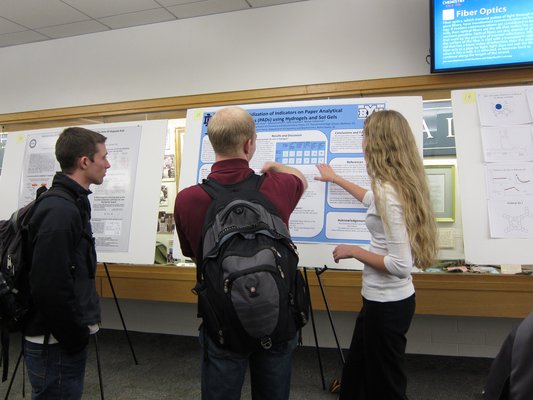
A student discusses her research project with others at the Research Poster Session.
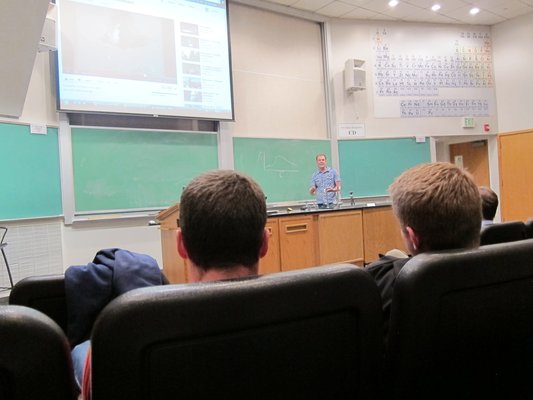
Graduate student Trevor Smith presents some of his research on nano-explosives at the Nano Symposium.
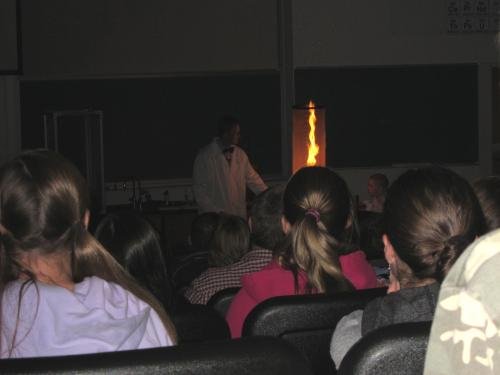
Connor, a local boy fighting leukemia, turns a crank to form a tornado of fire.
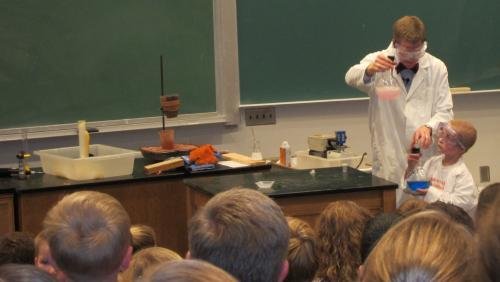
Connor helps shake up the sugars to turn two compounds pink and blue.
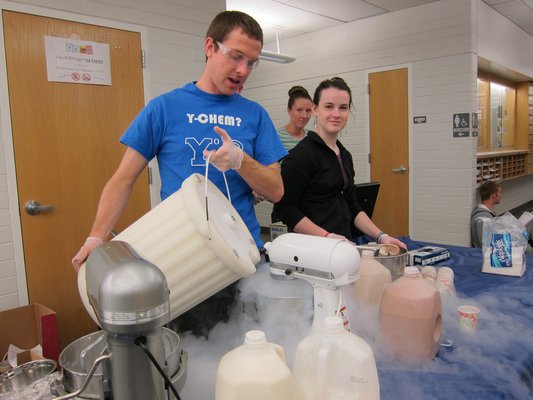
Members of the Y-Chem Society make liquid nitrogen ice cream to sell during their annual fundraiser throughout National Chemistry Week.
All photos by Jessica Henrie